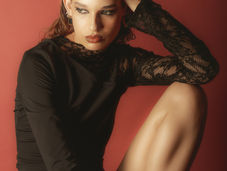'Joanna Piotrowska: All Our False Devices' Review - Tate Britain
- Sofia De Ceglie
- Mar 13, 2019
- 3 min read
8th March – 9th June 2019
FREE Entry
Enclosed in coloured frames, projected on blank walls and evoking images within and outside the pictures, Joanna Piotrowska’s All Our False Devices manages to make you feel safe and incredibly uncomfortable at the same time. The series will be on at the Tate Britain until the 9th of June as part of the gallery’s “Art Now” initiative, promoting emerging British artists.
A collection of newly released films and black and white photographs from past projects of the Polish-born, London-based artist, the installation explores concepts of home and human psychology, combining craft and emotional expression of bodily language and objects. Both unnatural and authentic, they leave the viewer perplexed in the powerful nature of these simple snapshots and brief seconds of movement.
The ability of merging these two opposite sensations comes with the purpose of the project itself and the bodies of work it encompasses. Drawing from two of her previous works, Piotrowska’s approach and the composition of the exhibition blends the lines between them, despite their tones and approaches being distinguished.

© Joanna Piotrowska, Untitled 2017, courtesy of Dawid Radziszewski
On one hand, there is spaces within the single room of the exhibit filled by pictures from the 2016-2018 Shelters collection. Makeshift shelters within homes and gardens, sometimes featuring their “architects”, visualise a sense of home and security; depicting people within their domestic sphere, in daily acts and surrounded by mundane objects becomes a way of finding comfort, reinventing spaces and seeking creative imagination within one’s self and the space they occupy. Sharp geometric angles of the objects mark the focus of the images, drawing attention to the details within such shelters. It speaks of childhood play and building forts, this time featuring grown ups who are sometimes uncomfortably tall or professionally-dressed, not conventionally considered to be part of such a sphere.
“Uncomfortable” is, once again, the right word to describe this part of the collection, juxtaposing elements of nature with man-made objects. Suffocating shelters and nostalgic images of juvenility permeate the chairs and cloths laid to cover them up. Perhaps it is homelessness, the loneliness of the subjects within their decrepit structures, that the artist is bringing to light, exploring a house in an emotional, as well as physical, sense. By subverting the concepts of home and play, Piotrowska re-defines space and people’s relation with their mundane surroundings.

© Joanna Piotrowska, Untitled 2015, courtesy of Dawid Radziszewski
Intertwined with these spatial compositions, there are more pictures in black and white, belonging to the 2015 collection Self Defense. This time, people are depicted in positions which seem unnatural at first glance, their bodies twisted in uncomfortable manners. These are the snapshots taken from a body of work, based on self defence, focusing on courses aimed at women. The body, here, becomes a sanctuary of safety and a mode of shelter: there is no need for an outside shell or home to find security when one holds strength. It speaks of the empowerment of women and girls: the simplicity of normal bodies is turned into a tool of independence. Once again, the human body is always enclosed deeper than the wooden frames that delineate the prints; even in its setting, it seems trapped. Whether it be in its own positions dictated by society to protect against aggression, in finding strength yet losing the ability to move freely, or in surrounding components, there is a marking the subject’s limited independence and an extending of the background to circumscribe it. The effect of violence against women is evident in their depiction: cornered, dodging direct eye contact, their bodies tense to seek protection and dauntingly empty surroundings make the pictures seem emotionally drained and hollow.

© Joanna Piotrowska, Untitled 2014, courtesy of Southard Reid and Dawid Radziszewski
Piotrowska’s analysis of human physicality continues in three 33-mm films, projected onto blank spots in the walls. These, in quick changes of images, draw the viewer’s close attention to a sequence of body parts. By focusing on limbs and other aspects, one can observe them closely; meaning extends in a multitude of spheres that go beyond their physical qualities and onto to their significance in society. In a short film of women pointing to several parts of their bodies, deconstructing their physicality, and the sexualisation that is attributed to it, the viewer realises that dissociation is necessary. Objectively considering a thigh, as a thigh makes it lose its objectifying and sexualising meaning, leaving us with the realisation that these are just anatomical structures; the constant eye contact with the camera creates a sensation of unease.
Through a manipulation of uncomfortable feelings and a retelling of social structures, the concepts of home and human psychology, Piotrowska succeeds in reshaping the meaning of physicality, shelter and safety whilst highlighting the position of women’s bodies in relation to it.
Edited by Evangeline Stanford, Digital Editor
























Comments